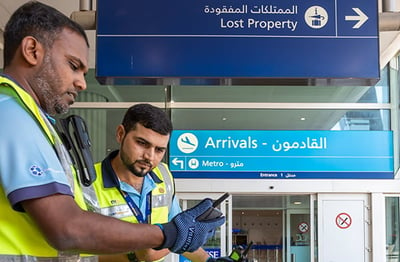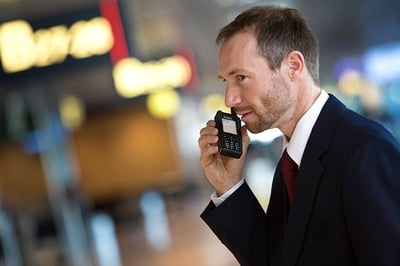Arriving at an airport, whether for a holiday or a business trip, you expect things to go smoothly. Check-in, security, luggage handling, boarding – all depend on good communications. This blog post explains why a hybrid TETRA/broadband network really meets an airport’s needs.
Airport visitors are always just passing through. Despite the attractions of duty free shopping, most people just want to get the process done as quickly as possible. Airport operators naturally want to guarantee a smooth experience for airport customers, but to really achieve this goal, one of the essentials is an efficient communications system.
Many airports are using TETRA/Tetrapol digital radio to take full advantage of group communication in their daily operations. In fact, of the 10 airports offering the best travelers’ experience (according to SKYTRAX World Airport Awards 2019), 8 have adopted TETRA/Tetrapol radio communication.

TETRA’s unique capabilities, such as near-instant connection times, its mission-critical availability and reliability and its many security features, are gold dust for a time-critical environment like an airport.
Many new high-bandwidth applications are generating a lot of interest from airports, particularly those for location, fleet management and especially shared situational awareness. All the relevant parties need access to the same information during incidents and apps designed for airports can run on their smartphones or tablets, whichever is most convenient.
Bringing everything together
A hybrid network combining TETRA and broadband is the way to reap the benefits of both mission-critical communications and professional broadband apps.
A hybrid network is simply a TETRA radio network and an LTE network, either dedicated or commercial, used in parallel. With the right implementation, TETRA radios and smartphone users can communicate seamlessly in groups.
Take the Tactilon Agnet app, for example. When plane boarding in underway, staff checking passports and those loading the luggage could talk in the same group, even though some use a smartphone rather than a TETRA radio.
And smartphones could have a situation app showing the location of each check-in team, helping plan the next flight.
Tactilon Agnet on a smartphone makes it possible to communicate in a TETRA talk group. With people who carry a TETRA radio and also with the control room. Even when the smartphone user isn’t in the area of TETRA network coverage!

Another option for hybrid communication is the new Tactilon Dabat, which is both a TETRA radio and a smartphone. Tactilon Dabat is designed for professional users who often need to be involved in TETRA communications and who also need a rugged, strong and safe smartphone.
For example, the fire chief at the airport could use the TETRA radio side of the device to manage teams, while the smartphone would offer situational awareness apps for more information.
In short, a hybrid network means that airport staff can use their preferred device and still take advantage of both TETRA communications and new broadband apps.
One more thing is essential - a single tool that lets you manage all users, both TETRA and smartphone. Good news is that such a tool exists: several network operators use the Tactilon Management tool for managing just this.
A hybrid TETRA and LTE network really is a great idea for airports. How to achieve it? Download the new white paper “How an airport should move to LTE the professional way”
Read more about Airbus airport customers and the Digital airports concept
--- This blog post was updated in April 2020 to reflect the latest available information.





